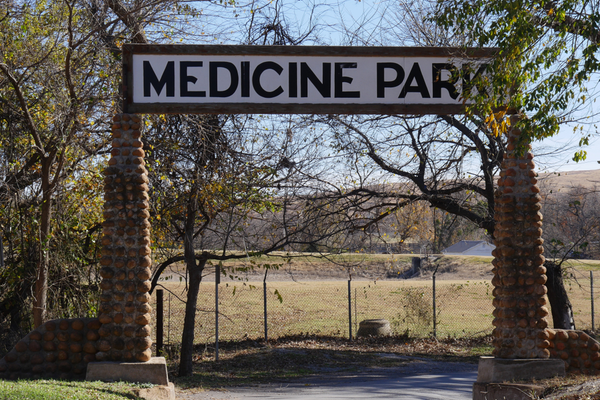In the summer of 1908, Elmer Thomas and his partners opened the Medicine Park Summer Resort and Health Spa in the eastern foothills of the Wichita Mountains near Medicine Creek. It was seven years after the opening of the Kiowa Comanche Apache Reservation, and less than one year after Oklahoma statehood.
Local Indians told Thomas that the creek, which flows through the center of town, had medicinal properties and the future politician and state leader built a resort that attracted people from all over the country. The small village, known as the “Queen of the Southwest” was a thriving summer resort in its early years. Medicine Park was an Oklahoma example of the health/spa/resort trend that promoted therapeutic healing, an idea that was popular throughout the nation.
The Medicine Park Summer Resort and Health Spa enjoyed rapid growth during its early years. By the late 1920s, the community consisted of a dance hall, several rental cabins and two hotels – Medicine Park Resort Hotel and the Apache Inn. The Medicine Park Resort Hotel underwent a few name changes and was first known as the Outside Inn. It was later changed to the Grand Hotel and then to the Old Plantation.
Medicine Creek was dammed to create two recreational lakes – Bath Lake and Lake Gondola, which is an Italian word that means long, narrow boat. Bath Lake drew thousands to bathe and swim in its “pure and medicinal” waters, wrote Peter J. McCormick in the Fall 1997 issue of “Chronicles of Oklahoma.” Lake Gondola was purposed for fishing and boating. A bridge was built connecting the east side and the west banks where several cabins and homes had been built.
The area thrived under Thomas’ vision and leadership, was dubbed an instant success, and grew quickly over the next 20 years. McCormick reported in his article that during its most popular time, Medicine Park drew more than 200,000 visitors to the park each year, with most people coming in from Texas. It also drew noteworthy, infamous visitors such as Bonnie and Clyde (Bonnie Parker and Clyde Barrow), Charles “Pretty Boy” Floyd, and Al Capone. The resort area was described as having a festive atmosphere, with orchestras playing in the ballroom of the Old Plantation.
In 1922, a local doctor by the name of Charles Baird opened a sanitarium and health clinic on the east banks of Medicine Creek. His business specialized in mineral and Turkish baths. Medicine Park had been proclaimed by a local newspaper to be the “natural health and pleasure grounds of the Southwest” and predicted it would become “the most attractive resort east of the Rocky Mountains and Lawton to be the Colorado Springs of the Plains.”
“Unfortunately, … (Lawton) never paralleled Colorado Springs and Medicine Park never held the status of the venerable Broadmoor Hotel,” McCormick wrote. He surmised part of the reason was due to the presence of other health resorts in southern Oklahoma — Sulphur and Bromide. Both locations had natural springs and resort hotels.
“The sanitariums and bath houses in Sulphur, located adjacent to the newly created Platt National Park and the Arbuckle Mountains, offered ‘every bath and electrical treatment known to science.’ Moreover, more than 150 spas were located in Texas, including Mineral Springs and Marlin, both of which drew nearly 100,000 visitors annually between 1900 and 1929,” McCormick wrote.
Eight years after founding the Medicine Park Summer Resort and Health Spa, in 1914, Thomas sold the little village to D.L. Sleeper and Associates of Oklahoma City for $16,000. Thomas, known as “The Sage of Medicine Park,” was pursuing a political career that took him to the national level. However, due to a default on the loan, Thomas and his partner took possession of the cobblestone community once again. He was often absent from the park, however, due to his public duties in Washington, D.C.
Despite Thomas’ vision of Medicine Park being a public destination, the community became more privatized, as investment in homes outpaced rental cabins and local businesses. Thomas contributed to this, himself, as he sold lots to finance the building and operation of the park. A permanent local population moved in and the shift from a public park to a small town was marked by the construction of a schoolhouse.
In 1926, ownership of Medicine Park passed to a local corporation owned by professionals and doctors. With the onset of prohibition, the privatized area became a haven for gamblers. The hotel offered gaming, slot machines and whiskey.
Ownership went back and forth between Thomas and other investors and in 1939 Lulabelle Young Hutchins purchased the resort and opened a small zoo with monkeys, bears and a skating rink. She also updated the Apache Inn and built a bathhouse, slide and swinging bridge at the lakes. Large crowds were drawn to weekend dances.
Baird’s sanitarium burned in 1939, followed by the Apache Inn and the third floor of the Old Plantation in 1940, McCormick wrote. The remaining buildings were sold to the Texas Land Company in 1954. The resort became almost completely out of operation by 1960. The health-seeker resort and spa days had ended. Medicine Park incorporated in 1969.
Sources for this article include Chronicles of Oklahoma, gateway.okhistory.org, Vol. 75, No. 3, Fall 1997, pages 244-261, “River Rock Resort: Medicine Park’s Landscape and Wichita Mountain Vernacular Architecture” by Peter J. McCormick; collinsdictionary.com; Oklahoma Historical Society, okhistory.org, “Medicine Park” by M. Lillian Stanfield; “Medicine Park: Oklahoma’s First Resort” by David C. Lott.


